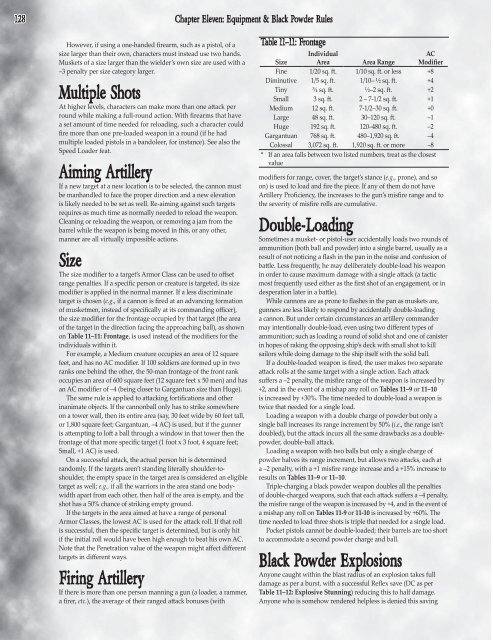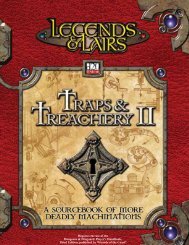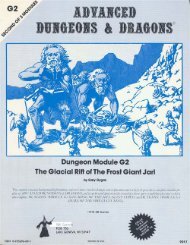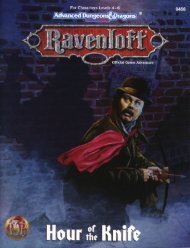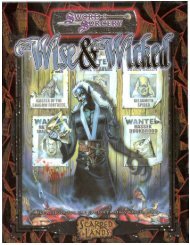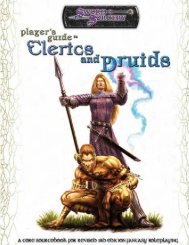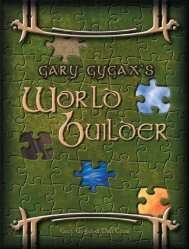Mythic Vistas: SpirosBlaak - Property Is Theft!
Mythic Vistas: SpirosBlaak - Property Is Theft!
Mythic Vistas: SpirosBlaak - Property Is Theft!
You also want an ePaper? Increase the reach of your titles
YUMPU automatically turns print PDFs into web optimized ePapers that Google loves.
128<br />
However, if using a one-handed firearm, such as a pistol, of a<br />
size larger than their own, characters must instead use two hands.<br />
Muskets of a size larger than the wielder’s own size are used with a<br />
–3 penalty per size category larger.<br />
Multiple Shots<br />
At higher levels, characters can make more than one aack per<br />
round while making a full-round action. With firearms that have<br />
a set amount of time needed for reloading, such a character could<br />
fire more than one pre-loaded weapon in a round (if he had<br />
multiple loaded pistols in a bandoleer, for instance). See also the<br />
Speed Loader feat.<br />
Aiming Artillery<br />
If a new target at a new location is to be selected, the cannon must<br />
be manhandled to face the proper direction and a new elevation<br />
is likely needed to be set as well. Re-aiming against such targets<br />
requires as much time as normally needed to reload the weapon.<br />
Cleaning or reloading the weapon, or removing a jam from the<br />
barrel while the weapon is being moved in this, or any other,<br />
manner are all virtually impossible actions.<br />
Size<br />
The size modifier to a target’s Armor Class can be used to offset<br />
range penalties. If a specific person or creature is targeted, its size<br />
modifier is applied in the normal manner. If a less discriminate<br />
target is chosen (e.g., if a cannon is fired at an advancing formation<br />
of musketmen, instead of specifically at its commanding officer),<br />
the size modifier for the frontage occupied by that target (the area<br />
of the target in the direction facing the approaching ball), as shown<br />
on Table 11–11: Frontage, is used instead of the modifiers for the<br />
individuals within it.<br />
For example, a Medium creature occupies an area of 12 square<br />
feet, and has no AC modifier. If 100 soldiers are formed up in two<br />
ranks one behind the other, the 50-man frontage of the front rank<br />
occupies an area of 600 square feet (12 square feet x 50 men) and has<br />
an AC modifier of –4 (being closer to Gargantuan size than Huge).<br />
The same rule is applied to aacking fortifications and other<br />
inanimate objects. If the cannonball only has to strike somewhere<br />
on a tower wall, then its entire area (say, 30 feet wide by 60 feet tall,<br />
or 1,800 square feet; Gargantuan, –4 AC) is used, but if the gunner<br />
is aempting to lo a ball through a window in that tower then the<br />
frontage of that more specific target (1 foot x 3 foot, 4 square feet;<br />
Small, +1 AC) is used.<br />
On a successful aack, the actual person hit is determined<br />
randomly. If the targets aren’t standing literally shoulder-toshoulder,<br />
the empty space in the target area is considered an eligible<br />
target as well; e.g., if all the warriors in the area stand one bodywidth<br />
apart from each other, then half of the area is empty, and the<br />
shot has a 50% chance of striking empty ground.<br />
If the targets in the area aimed at have a range of personal<br />
Armor Classes, the lowest AC is used for the aack roll. If that roll<br />
is successful, then the specific target is determined, but is only hit<br />
if the initial roll would have been high enough to beat his own AC.<br />
Note that the Penetration value of the weapon might affect different<br />
targets in different ways.<br />
Firing Artillery<br />
If there is more than one person manning a gun (a loader, a rammer,<br />
a firer, etc.), the average of their ranged aack bonuses (with<br />
Chapter Eleven: Equipment & Black Powder Rules<br />
Table 11–11: Frontage<br />
Individual<br />
AC<br />
Size Area Area Range Modifier<br />
Fine 1/20 sq. . 1/10 sq. . or less +8<br />
Diminutive 1/5 sq. . 1/10– ½ sq. . +4<br />
Tiny ¾ sq. . ½–2 sq. . +2<br />
Small 3 sq. . 2 – 7-1/2 sq. . +1<br />
Medium 12 sq. . 7-1/2–30 sq. . +0<br />
Large 48 sq. . 30–120 sq. . –1<br />
Huge 192 sq. . 120–480 sq. . –2<br />
Gargantuan 768 sq. . 480–1,920 sq. . –4<br />
Colossal 3,072 sq. . 1,920 sq. . or more –8<br />
* If an area falls between two listed numbers, treat as the closest<br />
value<br />
modifiers for range, cover, the target’s stance (e.g., prone), and so<br />
on) is used to load and fire the piece. If any of them do not have<br />
Artillery Proficiency, the increases to the gun’s misfire range and to<br />
the severity of misfire rolls are cumulative.<br />
Double-Loading<br />
Sometimes a musket- or pistol-user accidentally loads two rounds of<br />
ammunition (both ball and powder) into a single barrel, usually as a<br />
result of not noticing a flash in the pan in the noise and confusion of<br />
bale. Less frequently, he may deliberately double-load his weapon<br />
in order to cause maximum damage with a single aack (a tactic<br />
most frequently used either as the first shot of an engagement, or in<br />
desperation later in a bale).<br />
While cannons are as prone to flashes in the pan as muskets are,<br />
gunners are less likely to respond by accidentally double-loading<br />
a cannon. But under certain circumstances an artillery commander<br />
may intentionally double-load, even using two different types of<br />
ammunition; such as loading a round of solid shot and one of canister<br />
in hopes of raking the opposing ship’s deck with small shot to kill<br />
sailors while doing damage to the ship itself with the solid ball.<br />
If a double-loaded weapon is fired, the user makes two separate<br />
aack rolls at the same target with a single action. Each aack<br />
suffers a –2 penalty, the misfire range of the weapon is increased by<br />
+2, and in the event of a mishap any roll on Tables 11–9 or 11–10<br />
is increased by +30%. The time needed to double-load a weapon is<br />
twice that needed for a single load.<br />
Loading a weapon with a double charge of powder but only a<br />
single ball increases its range increment by 50% (i.e., the range isn’t<br />
doubled), but the aack incurs all the same drawbacks as a doublepowder,<br />
double-ball aack.<br />
Loading a weapon with two balls but only a single charge of<br />
powder halves its range increment, but allows two aacks, each at<br />
a –2 penalty, with a +1 misfire range increase and a +15% increase to<br />
results on Tables 11–9 or 11–10.<br />
Triple-charging a black powder weapon doubles all the penalties<br />
of double-charged weapons, such that each aack suffers a –4 penalty,<br />
the misfire range of the weapon is increased by +4, and in the event of<br />
a mishap any roll on Tables 11-9 or 11-10 is increased by +60%. The<br />
time needed to load three shots is triple that needed for a single load.<br />
Pocket pistols cannot be double-loaded; their barrels are too short<br />
to accommodate a second powder charge and ball.<br />
Black Powder Explosions<br />
Anyone caught within the blast radius of an explosion takes full<br />
damage as per a burst, with a successful Reflex save (DC as per<br />
Table 11–12: Explosive Stunning) reducing this to half damage.<br />
Anyone who is somehow rendered helpless is denied this saving


